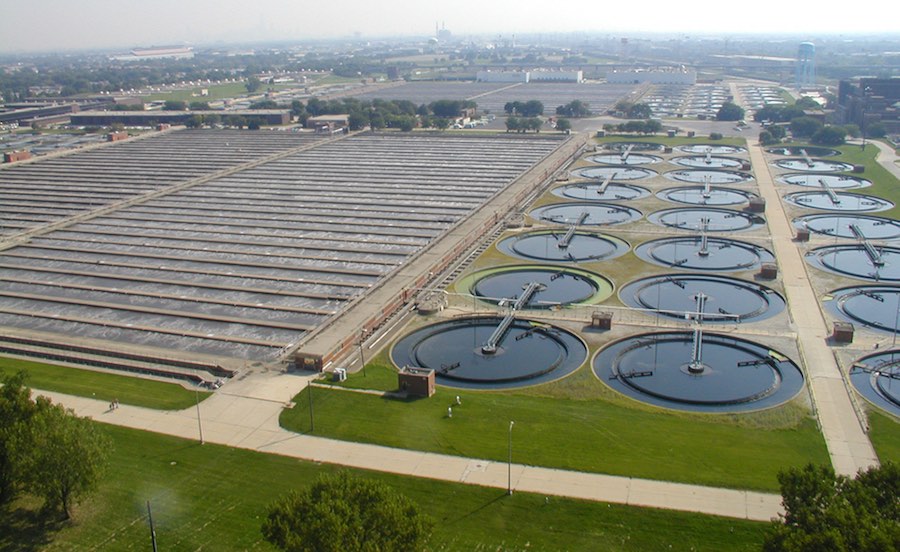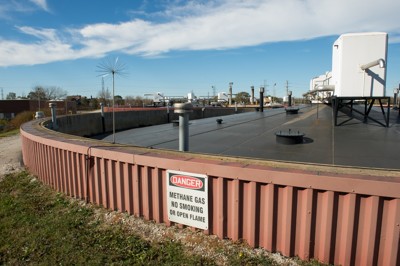Chicago’s wastewater authority plans to slash its energy bill by using bacteria to convert sewage into natural gas.

There are a lot of things in the 1.2 billion gallons that pour through the world’s largest water-treatment plant every day: grime swept off Chicago sidewalks, sewage scoured from thousands of miles of pipes—and enough energy to cut an annual $50 million electricity bill to zero.
That’s if engineers at Chicago’s Metropolitan Water Reclamation District can achieve their goal to become energy neutral in the next eight years. The public agency has pledged, by 2023, to slash its energy consumption and produce whatever remaining power it needs onsite, becoming the largest wastewater treatment authority in the country to do so.
“There’s more energy in the sewage that comes into a wastewater treatment plant than is required to treat it.”
MWRD isn’t the only sewage treatment agency doing this. DC Water and Hampton Roads Sanitation District in Virginia are also taking aggressive steps to recast wastewater as energy.
“There’s more energy in the sewage that comes into a wastewater treatment plant than is required to treat it,” according to Paul Kohl, a project manager for the Water Environment Research Foundation, an independent research organization. “We think we ought to be able to go ahead and get that back out.” By some estimates, there’s two to 10 times as much energy contained in wastewater as an agency needs to use to treat it.
From our partners:

While water treatment accounts for just 3 percent of total energy use in the United States, WERF points out that drinking water and wastewater plants can be a municipal government’s largest energy consumers, eating up more than a third of the energy used by the public sector. Many treatment processes are energy intensive, from aerating huge vats of liquid with 3,000-horsepower blowers to pumping sludge out of the system so it can be recycled as “biosolids.”
And that economic incentive is a big reason why typically slow-moving public agencies like MWRD—which was sued by environmental groups before it started disinfecting the water it discharges into the Mississippi River system—are eager to invest in energy neutrality. Not only does it negate a $50 million electricity bill (MWRD’s biggest expense after payroll), it helps them hedge against future spikes in the cost of energy.
“Some people do it for the environmental benefit, but I was raised as a business person,” says David St. Pierre, MWRD’s executive director. “Having your own energy source, we can convert it to anything we need. So if the market drives costs, we can really kind of control that unforeseen cost of energy in the future.”
The district already gets almost a third of its energy through anaerobic digestion: harvesting gas produced by special bacteria that help break down the noxious components of wastewater. But it plans to double down on that strategy, investing $10 million to expand anaerobic digestion efforts at its Calumet plant on Chicago’s South Side.
“The plan is to build a pipeline system that could scrub some of the methane produced in MWRD’s digesters and sell it back to the grid.”
It’s even in late-stage talks with local haulers who will pay MWRD to take their waste—mostly spent grain that’s left over from local breweries—which has a multiplying effect on the amount of gas produced when mixed in with sewage and stormwater. The plan is to build a pipeline system that could scrub some of the methane produced in MWRD’s digesters and sell it back to the grid.
Incorporating organic waste from outside the wastewater treatment process is an unusual, and logistically difficult, step. Earlier this year, the city of Gresham, Oregon, celebrated achieving net-zero-energy status at its wastewater treatment plant, largely thanks to the fats, oils, and grease it trucked in from Portland-area restaurants. Rather than just add incrementally to the gas produced, mixing organic wastes fires up the microbial activity that produces biogas, exponentially improving a digester’s output.

If it works at Calumet, MWRD will bring the whole system to its flagship Stickney plant, the world’s largest, and generate enough power on-site to offset three-quarters of its energy use. It will get the rest of the way to energy neutral by reducing demand, St. Pierre says, and should pay off the initial investment in just a few years.
Anaerobic digestion isn’t new—more than 1,200 wastewater treatment agencies across the country already use it—but just a few sell gas or electricity back to the grid, as MWRD plans to. Fewer still produce enough energy onsite to offset their energy consumption. But as more of them see wastewater as a potential source of revenue that could hedge against climbing energy costs, the aggressive steps taken in Hampton Roads, D.C., Chicago and elsewhere should become more widespread.
Still, St. Pierre says, their program isn’t wholly cost-driven.
“We’re an environmental agency, and our plants should be able to support themselves.”
This feature originally appeared in CityLab.















